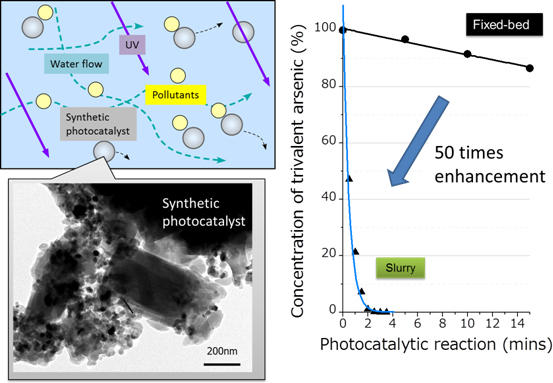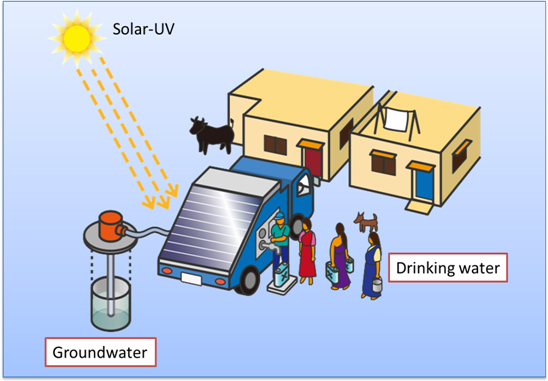Osaka, Japan - Panasonic Corporation today announced that it has developed a highly effective water purification system using a newly developed photocatalyst. This system is capable of effective detoxification of polluted water[1] by harmful heavy metals, such as arsenic, chromium, and persistent organic matter at a reaction rate of up to 100 times that of conventional methods[2]. This developed photocatalyst has a unique structure and is easy to collect from the polluted water after the detoxification and is recyclable. Through this development, a water purification system which is small size and isolated from municipal water networks can be realized, making is suitable for developing countries, where safe and low cost drinking water is needed.
Increasing demands and shortage of clean drinking water resources due to the rapid development of industrialization, population growth and long-term droughts have become a global issue. In polluted areas, drinking water may contain metal pollutants at levels more than double international standards. The slurry photocatalytic water treatment technology[3] has the potential to resolve these problems that especially occur in contaminated groundwater since this technology efficiently reduces the toxicity of harmful pollutants by a maximum of 99.99%: trivalent arsenic and hexavalent chromium are converted into less harmful chemicals. As no consumption of chemical materials is carried out during the photocatalytic water treatment, the technology has a lower impact on the environmental in comparison to conventional chemical water treatments.
The developed technology has the following features:
- The separation rate of the particulate synthetic photocatalyst from water is optimized by means of the designing of surface physicochemical properties of the photocatalyst.
- The photocatalyst possesses a large surface-area to volume-ratio which contributes the efficient detoxification of the harmful pollutants. Throughput of water treatment is thoroughly enhanced by this photocatalyst incorporated in the slurry photocatalytic water treatment technology, by 50 times in the case of arsenic pollutants and by 100 times in the case of persistent organic materials.
- Solar UV light is utilized as a light source for the slurry photocatalytic water treatment technology, making a low cost and environmentally friendly treatment system.
- Synthesis technology of the photocatalyst by utilizing the inherent electrostatic interaction between two particles
- Slurry technology to control the transition between the particulate photocatalyst aggregation and the suspension.
Panasonic holds 10 Japanese patents and 6 overseas patents, including pending application, for this development.
A part of this technology has been demonstrated in the joint research subjects with the Department of Chemical Engineering, Indian Institute of Science in Bangalore, India.
More on the Technology
1. Synthesis technology of the photocatalyst by utilizing the inherent electrostatic interaction between two particles
The fixation of the particulate photocatalyst on a large inert substrate reduces the surface of the photocatalytic active site and also enlarges the mass transfer limitation of pollutants to the photocatalytic active site since binder chemicals used for the fixation of particulate photocatalysts are often deposited on the surface of photocatalysts, resulting in the decrease of the surface active site. Instead of binder chemicals, the developed technology uses the attractive force originated from electrostatic interaction. This force we have found out is specific to the combination between nanoparticulate TiO2 photocatalyst and a particular type of microparticulate zeolite. The TiO2 photocatalyst bound to the zeolite maintains the inherent amount of photocatalytic active site since there is no inhibitor at the interface between the two particles.
2. Slurry technology to control the transition between the particulate photocatalyst aggregation and the suspension.
Since the TiO2 photocatalyst was weakly bound to the surface of the zeolite, TiO2 photocatalysts could be desorbed from the surface of the zeolite by a simple agitation of the slurry solution. When the agitation is stopped, TiO2 photocatalysts could be bound to the surface of the zeolite again. This behavior has a responsibility for the fact that the photocatalyst possesses both a large surface active site and the separation feasibility from the water.
Notes
[1] effective detoxification of polluted water
Trivalent arsenic or hexavalent chromium is converted into the less harmful pollutant of pentavalent arsenic or trivalent chromium respectively by the photocatalytic reaction. In case of organic pollutants, a complete mineralization without creating any secondary pollutant takes place.
[2] Conventional methods
Thin films of photocatalyst originated from sol-gel mixed with particulate photocatalysts are prepared on a large inert substrate. The fixation of the photocatalysts results in increasing the difficulty in terms of the reaction efficiency.
[3] Slurry photocatalytic water treatment technology
During the detoxifying process the particulate photocatalysts are suspended in the water to be treated and then separated from the water to be reuse by an automatic transfer system. The post separation of the particulate photocatalysts had been the major obstacle toward the practical application so far.

Schematic illustration of slurry photocatalytic water treatment technology

Panasonic photocatalytic water treatment system isolated from the municipal water network
About Panasonic
Panasonic Corporation is a worldwide leader in the development and engineering of electronic technologies and solutions for customers in residential, non-residential, mobility and personal applications. Since its founding in 1918, the company has expanded globally and now operates over 500 consolidated companies worldwide, recording consolidated net sales of 7.30 trillion yen for the year ended March 31, 2013. Committed to pursuing new value through innovation across divisional lines, the company strives to create a better life and a better world for its customers. For more information about Panasonic, please visit the company's website at http://panasonic.net/.
Media Contacts:
- Tokyo Public Relations Office
Panasonic Corporation - Tel: 03-3574-5664 Fax: 03-3574-5699
- Panasonic News Bureau
- Tel: 03-3542-6205 Fax: 03-3542-9018






